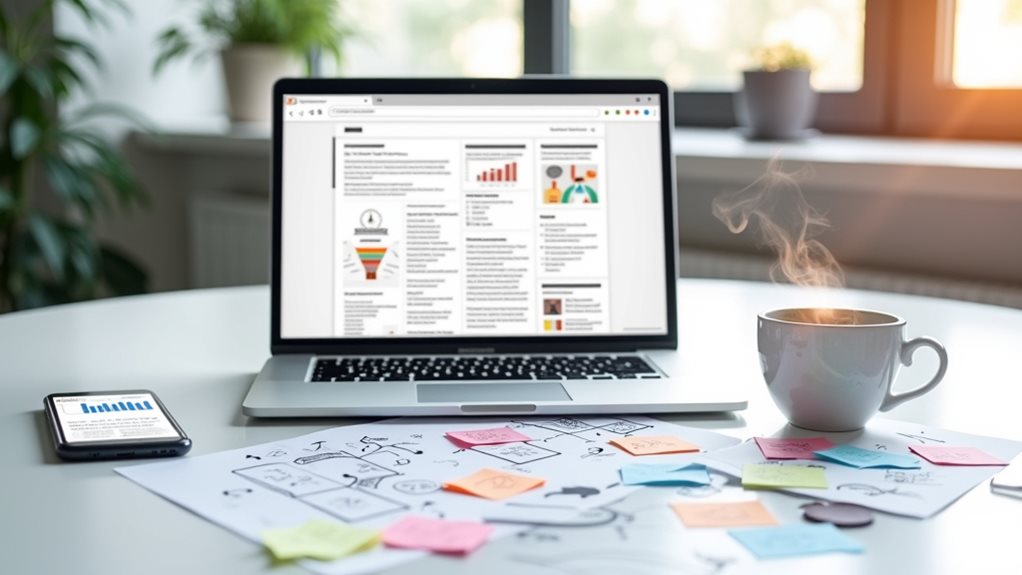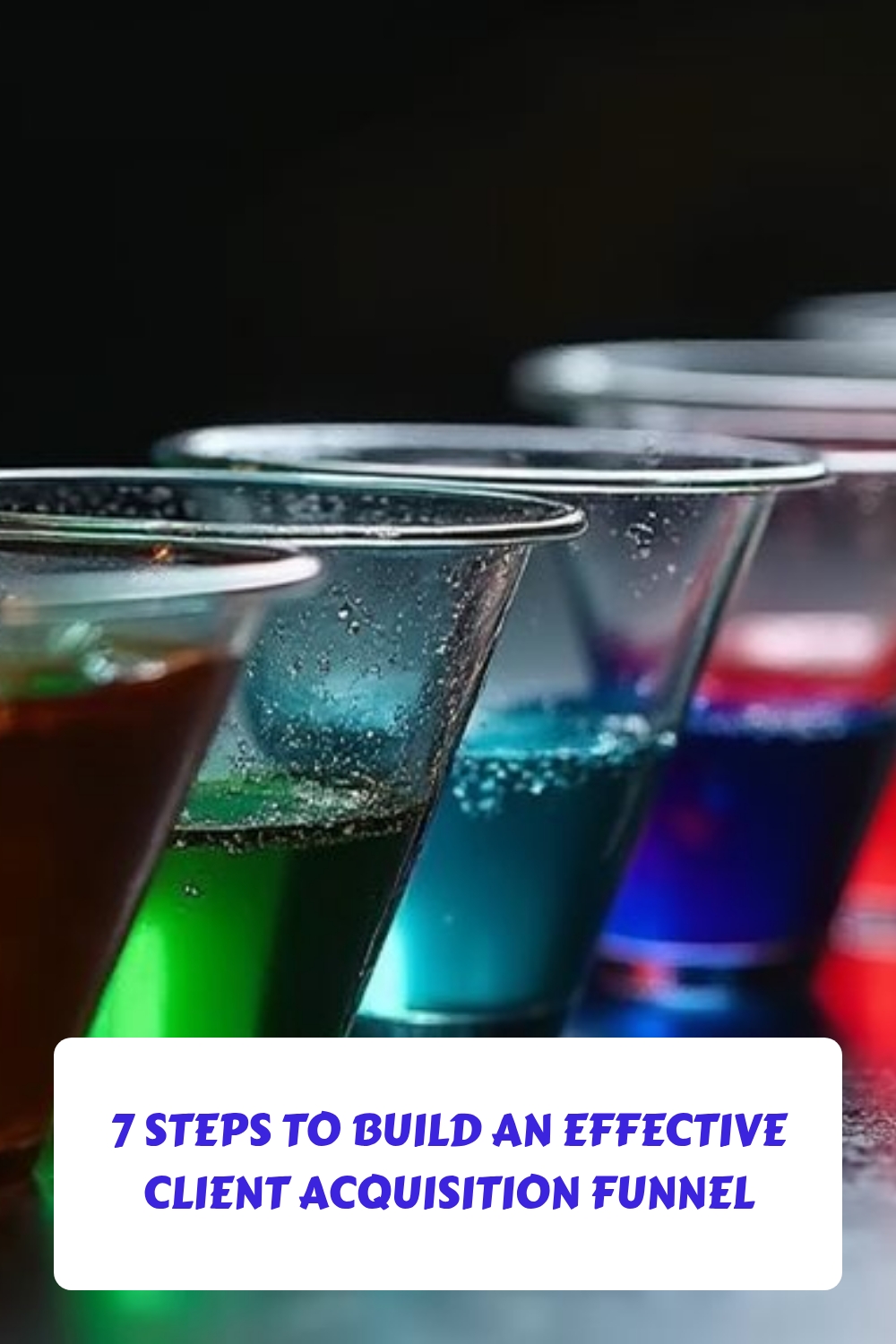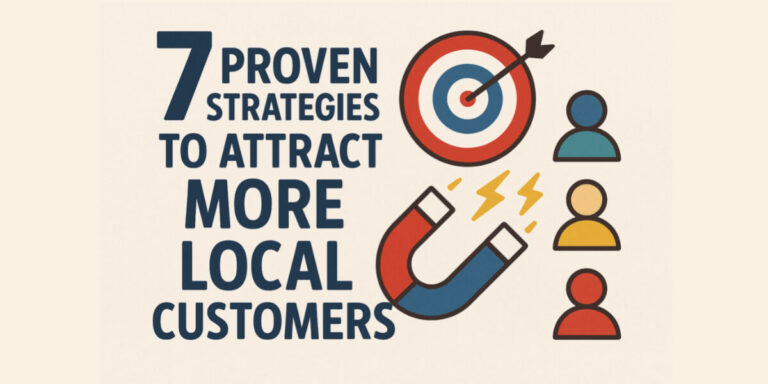
To build an effective client acquisition funnel, you’ll start by defining your ideal client profile through detailed buyer personas that include pain points and purchasing behaviors. Next, create compelling lead magnets like eBooks or webinars that address specific challenges, then design high-converting landing pages with clear objectives and social proof. Develop automated email sequences that build trust through valuable content, implement multi-channel follow-up systems, convert warm leads through consultations, and continuously optimize performance using data analytics to refine your approach.
Define Your Ideal Client Profile and Target Market

The foundation of any successful client acquisition funnel starts with crystal-clear knowledge of who you’re trying to reach. You can’t effectively attract clients if you’re casting a wide net hoping someone will bite.
Instead, you need to develop a detailed ideal client profile that goes beyond basic client demographics like age and income.
Start by analyzing your most profitable existing clients. What challenges do they face? How do they make purchasing decisions? Where do they spend their time online? This information becomes the backbone of your market segmentation strategy.
Consider creating buyer personas that include pain points, goals, preferred communication channels, and buying behaviors. The more specific you get, the better you’ll understand which marketing messages resonate and which channels deliver the highest-quality leads for your business. Additionally, incorporating SEO best practices into your strategy can significantly enhance your visibility in search engine results.
Create Compelling Lead Magnets That Attract Quality Prospects
You’ll need to select the right type of lead magnet that resonates with your ideal client’s specific pain points and immediate needs.
Your distribution strategy determines whether your carefully crafted lead magnet reaches the right people at the right time through the most effective channels.
Getting both elements working together creates a powerful system that consistently attracts qualified prospects who are genuinely interested in what you’re offering. Additionally, consider utilizing monthly blog posts to engage your audience and enhance the value of your lead magnets.
Types of Lead Magnets
When prospects encounter your business for the first time, they’re naturally hesitant to share their contact information without receiving something valuable in return. That’s where lead magnets become crucial tools for building trust and capturing quality leads.
You’ll find several effective formats to choose from. eBook formats work exceptionally well for providing thorough guides, templates, or industry insights that solve specific problems. They position you as an expert while delivering immediate value to your prospects.
Quiz incentives offer interactive engagement that prospects find irresistible. They tap into people’s curiosity about themselves while providing personalized results. Whether it’s a “What’s Your Marketing Style?” quiz or industry-specific assessments, these generate high engagement rates.
Other proven options include checklists, webinars, free consultations, and exclusive video content that directly addresses your target audience’s pain points.
Distribution Strategy Optimization
Creating powerful lead magnets is only half the battle—their success depends entirely on how strategically you distribute them across multiple channels.
You’ll need to identify where your ideal prospects spend their time and tailor your approach accordingly. Social media platforms, email campaigns, content marketing, and paid advertising each serve different purposes in your distribution arsenal.
Effective audience targeting requires deep understanding of your prospects’ behaviors and preferences. LinkedIn works exceptionally well for B2B professionals, while Instagram might better serve creative industries.
Don’t spread yourself too thin across every available channel—focus on three to four distribution channels where your audience is most active and engaged.
Test different messaging approaches for each platform, then double down on what generates the highest-quality leads consistently.
Design High-Converting Landing Pages That Capture Leads

Although your website attracts visitors through various marketing channels, converting those visitors into qualified leads relies on the effectiveness of your landing pages. Your landing page design must focus on a single, clear objective—capturing visitor information through compelling offers and streamlined forms.
Start with attention-grabbing headlines that directly address your target audience’s pain points. Include social proof through testimonials, client logos, or case studies to build immediate credibility.
Keep your forms simple, requesting only necessary information to reduce friction and improve your conversion rate. Design with mobile users in mind, guaranteeing fast loading times and intuitive navigation.
Use contrasting colors for call-to-action buttons, making them impossible to miss. Test different elements continuously—headlines, images, form lengths, and button placement—to optimize performance and maximize lead generation from every visitor.
Develop an Email Nurture Sequence That Builds Trust
Once you’ve captured leads through your landing pages, you’ll need to transform those initial contacts into trusted relationships through strategic email nurturing.
Your success depends on three critical components: segmenting your audience based on their specific needs and behaviors, creating content that delivers genuine value rather than just promotional messages, and implementing automated follow-up sequences that maintain consistent engagement without overwhelming your prospects.
These elements work together to build the trust necessary for converting leads into paying clients.
Segment Your Audience Properly
Most business owners treat their email lists like a giant megaphone, blasting the same message to everyone regardless of where they’re in their buying process or what specific problems they’re facing. This approach kills conversion rates and frustrates potential clients who receive irrelevant content.
Effective segmentation starts with audience demographics like age, location, and income level. However, behavioral segmentation proves more powerful for conversions. You’ll want to track how subscribers interact with your content, which emails they open, and what links they click.
Create segments based on purchase history, engagement levels, and where people entered your funnel. Someone who downloaded your free guide needs different messaging than someone who attended your webinar.
This targeted approach enhances open rates by 39% and drives notably more qualified leads.
Craft Value-Driven Content
When your email sequence constantly pushes for sales without delivering genuine value, you’ll watch subscribers hit the unsubscribe button faster than you can say “conversion rate.”
Building trust through your nurture sequence requires a complete shift in mindset—from seller to educator, from pitcher to problem-solver.
Your content marketing strategy must prioritize authentic audience engagement over aggressive promotion.
Here’s how to create compelling nurture emails:
- Share industry insights that position you as a knowledgeable resource
- Tell client success stories that demonstrate your expertise without bragging
- Provide actionable tips subscribers can implement immediately
- Address common pain points your ideal clients face regularly
Automate Strategic Follow-Ups
While creating valuable content forms the foundation of effective email marketing, strategic automation guarantees your messages reach subscribers at precisely the right moments to maximize engagement and trust-building.
You’ll need to establish automated reminders that trigger based on specific subscriber behaviors, like downloading resources or visiting pricing pages.
Create follow-up templates for different scenarios: new subscribers receive welcome sequences, inactive users get re-engagement campaigns, and prospects near purchase decisions receive testimonials and case studies.
Your automation should feel personal, not robotic. Schedule emails at ideal times when your audience is most active.
Include clear calls-to-action and track open rates to refine your approach. This systematic nurturing transforms cold leads into warm prospects ready for meaningful sales conversations.
Implement Strategic Follow-Up Systems Across Multiple Channels
Strategic follow-up systems function as the backbone of successful client acquisition, transforming initial interest into lasting business relationships through consistent, multi-channel engagement.
You’ll maximize conversion rates by coordinating touchpoints across email, phone, social media, and direct mail platforms.
Effective multi-channel engagement requires precise follow-up timing to maintain momentum without overwhelming prospects.
Here’s your implementation framework:
- Email sequences – Deploy automated drip campaigns with valuable content delivered every 3-5 days
- Phone outreach – Schedule personal calls within 24 hours of initial contact, then weekly thereafter
- Social media touches – Engage with prospects’ posts and share relevant industry insights consistently
- Direct mail surprises – Send handwritten notes or branded materials at strategic milestone moments
This systematic approach guarantees you’re present across all communication channels your prospects prefer while maintaining professional persistence.
Convert Warm Leads Through Consultations and Sales Conversations

As warm leads move through your acquisition funnel, they’re signaling genuine interest and readiness for deeper engagement—making this the vital moment where relationships transform into revenue. Your consultation becomes the bridge between interest and commitment, requiring strategic finesse rather than aggressive pitching.
Effective consultation techniques focus on uncovering pain points and desired outcomes through thoughtful questioning. You’ll want to listen more than you speak, positioning yourself as a problem-solver rather than a vendor.
Understanding sales psychology means recognizing that people buy emotionally and justify logically—so connect with their feelings first.
Structure your conversations around their challenges, not your services. Present solutions as natural outcomes of their expressed needs. This approach builds trust while demonstrating value, making the shift from prospect to client feel inevitable rather than pressured.
Optimize Your Funnel Performance Using Data and Analytics
Once your consultation process starts converting warm leads, you’ll need concrete data to understand what’s working and what’s bleeding potential revenue.
Funnel analytics become your compass for making informed decisions rather than flying blind with hunches.
Data-driven insights eliminate costly guesswork and transform your conversion strategy from wishful thinking into predictable revenue growth.
Performance metrics reveal the truth about your conversion rates at each stage. You can’t optimize what you don’t measure, so tracking these numbers becomes non-negotiable for sustainable growth.
Here’s what to monitor consistently:
- Lead source performance – Which channels deliver your highest-quality prospects
- Conversion rates by stage – Where leads drop off most frequently
- Cost per acquisition – How much you’re spending to land each client
- Customer lifetime value – The long-term revenue impact of your efforts
This data transforms guesswork into strategic decisions that compound your results.
Frequently Asked Questions
How Much Budget Should I Allocate for My Client Acquisition Funnel?
You’ll need a strategic budget breakdown based on your revenue goals and customer lifetime value. Start with 10-15% of projected revenue, then adjust through funnel optimization as you track conversion rates and cost-per-acquisition metrics.
What’s the Typical Timeline to See Results From a New Funnel?
You’ll typically see initial results within 30-60 days, but meaningful conversions take 3-6 months. Your funnel optimization strategies and lead nurturing techniques need time to mature, test, and refine before delivering consistent client acquisition results.
How Do I Handle Leads That Go Cold After Initial Contact?
You’ll revive cold leads through consistent lead nurturing strategies like personalized follow-up emails, valuable content sharing, and social media engagement. Implement re-engagement techniques including special offers, surveys, or direct calls to reignite their interest effectively.
Should I Outsource Funnel Management or Keep It In-House?
You should weigh outsourcing benefits like specialized expertise and cost savings against in-house advantages such as direct control and brand knowledge. Start in-house initially, then consider outsourcing specific components as you scale.
What Legal Compliance Issues Should I Consider When Collecting Leads?
You’ll need to comply with data protection laws like GDPR and CCPA when collecting leads. Make certain you’re following privacy regulations by obtaining proper consent, providing clear opt-out options, and securing personal information appropriately.
Final Thoughts
You’ve now got the blueprint for transforming strangers into loyal clients through strategic funnel building. Don’t expect overnight success—like a blacksmith forging iron, you’ll need patience and persistence to hammer out the perfect system. Track your metrics religiously, test different approaches, and refine each step based on real data. Remember, even the best funnel requires constant attention and optimization. Start implementing these steps today, and you’ll see your client acquisition dramatically improve within months.
- Writing Content That Converts Visitors Into Customers - 04/11/2025
- How to Plan a Content Calendar That Works - 29/10/2025
- SEO Content vs. Social Media Content: What’s the Difference? - 23/10/2025




